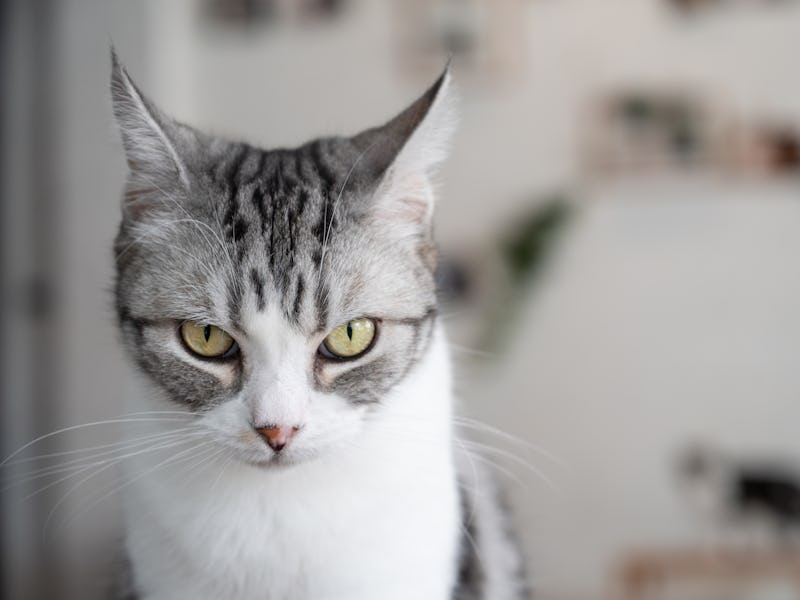Can Cats See Things That Humans Can't? Veterinarians Reveal What Cat Vision Is Really Like
Here’s what’s going on inside your cat’s mystifying eyes.

If you could develop any of a cat’s sensory abilities, which would you choose? Perhaps hearing, so you can identify each of the many thousands of cockroaches in your building. Maybe proprioception so you, too, can fall from a four-story building and land on your feet. While these two senses offer a big upgrade in perceiving the world, you likely wouldn’t take sight. While big cats like cheetahs have impeccable vision for spotting prey far across the savannah, house cats don’t actually have great eyes.
So, what does their world look like? What can we see that they can’t? In 2013, artist Nickolay Lamm visualized how the world looks through a cat’s eyes. Among other key differences, like their expanded periphery and improved night vision, is their color perception. In these images, panoramic views blur and take on a desert-like palette. But where does their color perception start and end? Bruce Kornreich, veterinary cardiologist and director of the Cornell Feline Health Center, tells Inverse what’s going on inside those mystifying eyes and how it mediates a cat’s universe.
What colors can and can’t my cat see?
“They do well with blues and yellows,” Kornreich tells Inverse. But they have “a little more trouble … distinguishing greens and reds.” It’s not that cats can only see these two colors, but they’re better at detecting these colors’ nuances than others’. Blue and violet are at one end of that spectrum with shorter wavelengths, around 380 nanometers, while red is at the other end with long wavelengths at around 700 nm.
It’s not that cats can’t see reds and greens at all, Kornreich explains, “but they don't see them with the same richness of hue.” This richness of hue is known as saturation. Certain colors in Lamm’s cat-eye visualizations look washed out and not as vibrant. Red, for example, looks “just kind of like a dark color,” Kornreich describes. Cats can better detect vibrancy on the blue-yellow end of the spectrum than the green-red end, which has everything to do with the types of cells in their retinas.
How do cat eyes work?
The eye’s retinas are full of light-sensing cells called photoreceptors, like rods and cones. Rods help to see at night and help with peripheral vision, while cones enable colors to be seen. Feline cones contain two types of proteins called opsins. Opsins “change their structure when light hits them,” Kornreich says. As in, opsins literally change shape in response to visible light. However, each opsin is stimulated by different wavelengths, which determines what color light they perceive. The opsins they possess are especially sensitive to blue and yellow light, which is why they see these colors best.
Since cats’ cones have two opsins, which makes them what’s called dichromatic, meaning they best perceive two light colors. Humans have a third type of opsin, making our eyes trichromatic. But “it's not as if [cats] can only see two colors,” Kornreich says. Colors combine to create various blends that cats perceive at different degrees.
On the flip side, their rods give them solid night vision. They can better discern shapes in the dark, which is likely a predatory advantage for these crepuscular creatures. They evolved to hunt in the dim light of dawn and dusk, so a high contrast vision with low light comes in handy. According to the Merck Veterinary Manual, cats can see six times better than humans in dim lighting.
“They have lots of rods, that's presumably an evolutionary advantage because they often hunt in low light,” Kornreich says.
Should I only use colors my cat can see?
Still, there aren’t necessarily any advantages that come with spoiling your kitty with blue and yellow toys. If you’re disappointed that your cat can’t enjoy the Christmas season or, say, learn to read traffic lights, take comfort in the fact that they can perfectly see the tranquil expression on your face as they sit on your chest, watching as you sleep.
This article was originally published on